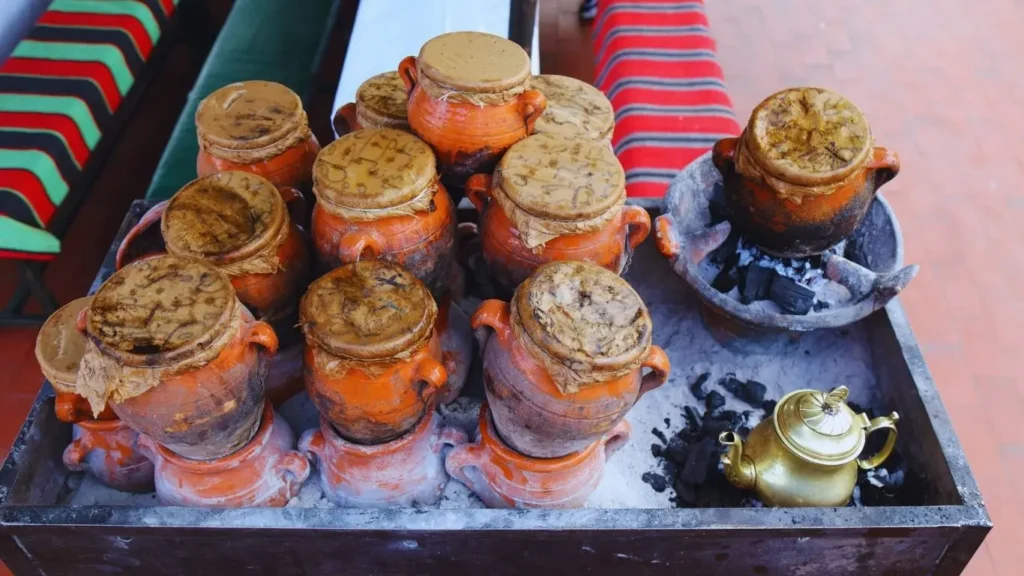how to make Moroccan tangia marrakchia meat and spices

Table of Contents
tangia slow-cooked beef is a staple of Moroccan cuisine, renowned for its tender texture and rich flavors. This dish, often referred to as tangia, is prepared using a blend of traditional spices and slow-cooking techniques that enhance its depth and aroma.
Key Takeaways
- slow-cooked beef is a classic dish in Moroccan cuisine.
- Slow cooking enhances the beef’s tenderness and flavor.
- This dish, known as tangia, is made using a blend of aromatic spices.
- Traditional ingredients and cooking methods define its unique taste.
- The result is a deeply flavorful and satisfying dish.
The Rich Heritage of tangia
Deeply rooted in Morocco’s culinary history, Moroccan slow-cooked beef has been enjoyed for generations. Originating in the bustling medina of Marrakech, this dish is a cornerstone of Moroccan gastronomy.

Origins in Marrakech’s Ancient Medina
The ancient medina of Marrakech is the birthplace of this dish. Its narrow streets and lively markets have long been home to cooks perfecting their craft. The authentic recipe for Moroccan slow-cooked beef has been passed down through time, preserving its rich flavors.
Traditional Preparation Methods
A key aspect of Moroccan slow-cooked beef is its traditional preparation. The dish is often slow-cooked in a clay pot, allowing the flavors to meld together. This method ensures a tender, succulent texture that makes the dish a favorite among food lovers.
Essential Ingredients for Authentic Tangia Marrakchia
To make an authentic tangia Marrakchia, high-quality ingredients are essential. The dish relies on tender beef and a carefully curated blend of spices, including cumin, coriander, cinnamon, and ginger.
A clay pot is traditionally used for cooking, as it distributes heat evenly and enhances the dish’s depth of flavor. Below are the key ingredients needed:
| Ingredient | Quantity |
|---|---|
| Beef | 1 pound |
| Olive oil | 2 tablespoons |
| Onion | 1, chopped |
| Garlic | 2 cloves, minced |
| Cumin | 1 teaspoon |
| Coriander | 1 teaspoon |
| Cinnamon | 1/2 teaspoon |
| Ginger | 1/2 teaspoon |
| Salt & Pepper | To taste |

By using these ingredients and traditional cooking techniques, you can create a flavorful tangia Marrakchia perfect for any occasion.
Mastering the Art of dish
Creating a perfect Moroccan slow-cooked beef dish requires attention to detail. From selecting the right cut of meat to using traditional cookware, every step plays a role in achieving the signature taste and texture.
Preparing the Meat and Spices
- Select a high-quality cut like brisket or shank.
- Marinate the beef in a mix of cumin, coriander, cinnamon, and ginger.
- Allow the meat to marinate for at least 24 hours for enhanced flavor.
Traditional Cooking Vessels
Clay pots are the preferred choice for cooking this dish. They ensure even heat distribution and help retain the flavors, resulting in a rich and satisfying taste.
| Cooking Vessel | Heat Distribution | Flavor Retention |
|---|---|---|
| Clay Pot | Even | High |
| Cast Iron Pot | Good | Medium |
The Secret Spice Blend
A well-balanced spice blend is the key to the authentic taste of Marrakesh beef stew. The core spices include:
- Cumin – Adds warmth and earthiness.
- Coriander – Lends a slightly sweet and citrusy note.
- Cinnamon – Contributes warmth and sweetness.
- Ginger – Provides a subtle heat.
- Paprika – Enhances the dish with a smoky touch.
Achieving the perfect balance of these spices is essential for a flavorful dish. By experimenting with different proportions, you can personalize the taste to suit your preference.
The Different Types of Tangia Marrakchia
Tangia Marrakchia is more than just a dish — it is a symbol of Marrakesh’s culinary heritage and social culture. Often associated with the city’s working-class men and gatherings in local hammams or workshops, Tangia is a slow-cooked meat stew traditionally prepared in a clay urn-shaped pot called a tangia. What makes it truly special is not only the technique and the container but also the unique spices and regional variations that influence the final flavor.
1. Classic Beef or Lamb Tangia
The most common and traditional version is made with lamb shoulder or beef shank. The meat is marinated in a blend of smen (fermented butter), preserved lemon, garlic, cumin, saffron, and sometimes ras el hanout. Once everything is combined in the clay pot, it is sealed and slow-cooked — traditionally buried in hot ashes or placed in the coals of a public oven (furnace rooms of bathhouses or bakeries). The result is fall-apart tender meat, deeply infused with earthy spices.
2. Chicken Tangia
Though less traditional, chicken tangia is a modern twist preferred by those seeking a lighter alternative. This version uses the same spice profile as the classic but typically includes green olives, and sometimes caramelized onions, adding a slight sweetness to balance the savory depth of the preserved lemon and garlic.
3. Vegetarian Tangia
In response to changing dietary habits and growing vegetarianism, a few chefs and home cooks have reimagined the dish without meat. The vegetarian tangia features a combination of seasonal vegetables such as carrots, zucchini, potatoes, and chickpeas, slowly cooked with the same tangia spices and olive oil. While unconventional, it maintains the spirit of the dish through slow cooking and spice layering.
4. Tangia with Camel Meat
In southern Morocco and among traditional meat lovers, a version of tangia using camel meat is highly appreciated. Camel meat, being leaner and more robust in flavor, requires longer cooking time but results in a dish rich in taste and tradition. This type of tangia is often cooked during special gatherings or festive events.
5. Tangia with Offal (Tangia Boulfaf)
Less common but deeply rooted in Moroccan culinary traditions is tangia made from offal — including liver, heart, kidneys, and sometimes intestines. This variation, often called Tangia Boulfaf, is favored by those who appreciate intense, bold flavors. It is particularly popular during Eid al-Adha when offal is readily available and freshly prepared.
Conclusion: Serving and Enjoying Your Moroccan Feast
slow-cooked beef is a dish meant to be savored. The tender beef, infused with aromatic spices, is best enjoyed with traditional sides such as couscous, vegetables, and fresh flatbread.
By following the traditional recipes and cooking methods outlined, you can bring the rich flavors of Moroccan cuisine into your home. Whether for special occasions or everyday meals, this dish is sure to impress and satisfy.
FAQ
What is slow-cooked beef?
Moroccan slow-cooked beef, also known as tangia Marrakchia, is a dish made by slow-cooking beef with a mix of spices in a clay pot. The result is tender and flavorful meat with a rich aroma.
Where does slow-cooked beef originate from?
This dish originates from the ancient medina of Marrakech, where it has been a staple for centuries.
What are the essential ingredients in Tangia Marrakchia?
The key ingredients include beef, olive oil, onion, garlic, cumin, coriander, cinnamon, and ginger. Cooking it in a clay pot enhances the flavor.
How is Moroccan slow-cooked beef prepared?
The beef is marinated with spices, then slow-cooked in a clay pot to achieve its signature tenderness and depth of flavor.
What is the secret spice blend used in Marrakesh beef?
The spice blend includes cumin, coriander, cinnamon, ginger, and paprika. The precise balance of these spices creates the dish’s signature taste.
How is Moroccan slow-cooked beef typically served?
It is traditionally served with couscous, vegetables, and warm flatbread, making for a complete and satisfying meal.
